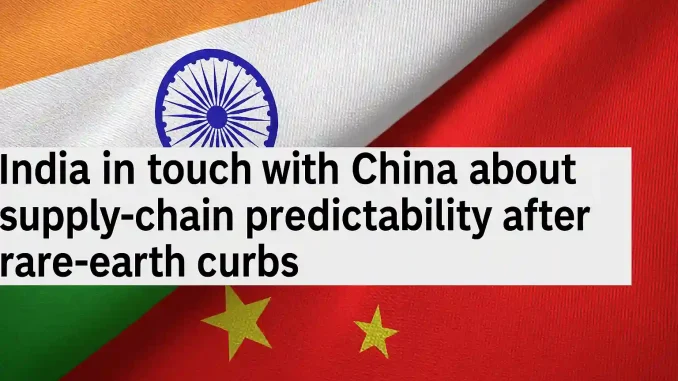
New Delhi/Beijing – In response to mounting uncertainty in the global supply of critical minerals, India has initiated diplomatic-level talks with China to address the fallout of Beijing’s recent export restrictions on rare-earth elements. The focus of the dialogue: ensuring supply-chain predictability for Indian industries—especially electric vehicles (EVs), electronics, and clean energy sectors—that depend heavily on rare-earth magnets imported from China.
China’s decision earlier this year to tighten export controls on certain rare-earth materials and technologies has rippled through global markets, prompting urgent policy responses from governments and industries worldwide. For India, which imports nearly 85% of its rare-earth magnets from China, the move has raised alarms about strategic vulnerability and industrial disruptions.
Background: China’s Rare-Earth Clampdown
In early 2025, China imposed licensing and end-user verification requirements for the export of high-performance rare-earth magnets and processing technologies. The policy change, which officially came into force in April, is part of Beijing’s broader strategy to guard its technological know-how and preserve domestic reserves for local industries.
Under the new regime, any company seeking to import Chinese magnets or rare-earth products must provide end-use certification (EUC), undergo government review, and wait weeks for approval. The result: shipping delays, inventory pile-ups, and rising costs for manufacturers globally.
For India, the effect has been immediate and significant, particularly for OEMs in the EV, defense, and electronics sectors.
India’s Diplomatic Response: Dialogue for Stability
Government officials in New Delhi confirmed that high-level discussions are underway with their Chinese counterparts to clarify the export process and restore predictability to the supply pipeline.
“We are in regular touch with the Chinese government to ensure that the new rules are not applied arbitrarily or punitively,” a senior official from India’s Ministry of Commerce told reporters. “India supports transparent global trade. However, sudden policy shifts create instability that hurts all stakeholders.”
The Indian government is reportedly advocating for simplified documentation and fast-tracking of magnet exports to Indian companies with legitimate civilian end-uses. Officials from the Ministry of External Affairs (MEA) and Ministry of Heavy Industries have jointly prepared a diplomatic dossier highlighting the downstream risks to India’s EV and clean-tech sectors.
Industries Impacted in India
The rare-earth bottleneck has hit several sectors:
- EV Manufacturers: Companies like Tata Motors, Mahindra Electric, and Ola Electric rely on neodymium magnets for traction motors. Delays in sourcing are disrupting motor assembly and leading to higher production costs.
- Auto Component Suppliers: Tier-1 and Tier-2 suppliers, many of whom source magnets from China via Hong Kong intermediaries, are experiencing 10–12 week shipment delays.
- Defense & Electronics: Radar systems, sonar, drones, and advanced computing systems require specific rare-earth components. The curbs have raised concerns within India’s defense R&D and indigenous production programs.
India’s Broader Strategy: Reduce Import Dependency
Even as it engages with China diplomatically, India is accelerating efforts to reduce its dependence on Chinese rare-earth imports.
Key developments include:
- Strategic Stockpiling: The government is reportedly evaluating the creation of a strategic rare-earth reserve akin to the petroleum stockpile system, allowing for buffer supplies in case of future shocks.
- Domestic Exploration: India’s Department of Atomic Energy and the Indian Rare Earths Limited (IREL) are ramping up mining activity in states like Andhra Pradesh, Odisha, and Tamil Nadu to increase domestic extraction and refining capacity.
- PLI Scheme Expansion: The government is considering a dedicated Production-Linked Incentive (PLI) program for rare-earth magnets and EV components, to encourage local production and attract private sector investment.
- Allied Partnerships: India is also in active discussions with countries like Australia, the US, and Vietnam to establish alternative rare-earth supply lines, technology partnerships, and joint refining ventures.
China’s Stance: Strategic Calculus or Trade Leverage?
Beijing insists that the new rules are not political but meant to protect intellectual property and ensure that critical technologies don’t fall into the wrong hands. However, many analysts see it as part of China’s broader geo-economic toolkit, used to exert pressure or signal its dominance over critical global resources.
“Rare earths are China’s strategic lever—like semiconductors are to the U.S.,” says Dr. Radhika Saxena, a trade policy expert. “Any country dependent on Chinese exports must now build contingencies.”
Outlook: Fragile Stability Ahead
While talks between India and China appear constructive, the situation remains fragile. Indian companies are being advised to diversify sourcing, explore long-term contracts, and invest in recycling and substitute materials wherever feasible.
Some progress has already been made. A few Indian companies have received EUC approvals from Chinese authorities, allowing limited shipments to proceed. However, the process remains bureaucratic and time-consuming.
Leave a Reply